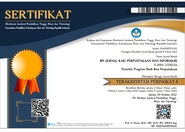ANALYSIS OF ANDROID-BASED E-LIBRARY USER SATISFACTION AT GALUH UNIVERSITY LIBRARY USING TAM AND EUCS
Abstract
Keywords
Full Text:
PDFReferences
J. Senanayake, H. Kalutarage, M. O. Al-Kadri, A. Petrovski, and L. Piras, “Android Source Code Vulnerability Detection: A Systematic Literature Review,” ACM Computing Surveys, vol. 55, no. 9. Association for Computing Machinery, Jan. 13, 2023. doi: 10.1145/3556974.
Statista.com, “Number of smartphone mobile network subscriptions worldwide from 2016 to 2022, with forecasts from 2023 to 2028.” Accessed: Nov. 08, 2023. [Online]. Available: https://www.statista.com/statistics/330695/number-of-smartphone-users-worldwide/
Statcounter, “Mobile Operating System Market Share Worldwide.” Accessed: Nov. 08, 2023. [Online]. Available: https://gs.statcounter.com/os-market-share/mobile/worldwide/%20
М. РЕВОЛЮЦИИ В БИЗНЕСЕ HarperBusiness, “REENGINEERING CORPORATION RE-ENGINEERING CORPORATION ST. PETERSBURG STATE UNIVERSITY.”
U. Gadjah Mada, “Tantangan dalam Mewujudkan Perpustakaan Digital Eko Noprianto.”
M. W. Anzaeni and L. Latifah, “Economic Education Analysis Journal Info Artikel,” 2017. [Online]. Available: http://journal.unnes.ac.id/sju/index.php/eeaj
F. A. Alijoyo and S. Norimarna, “Risk Management Maturity Assessment based on ISO 31000-A pathway toward the Organization’s Resilience and Sustainability Post COVID-19: The Case Study of SOE Company in Indonesia.”
A. A. Hanggono, S. R. Handayani, dan H. Susilo, 2015, “Analisis Atas Praktek Tam (Technology Acceptance Model) Dalam Mendukung Bisnis Online Dengan Memanfaatkan Jejaring Sosial Instagram”, Jurnal Administrasi Bisnis (JAB), Vol. 26, No. 1, September 2015.
F atmasari, M. Ariandi, 2014, “Penerapan Metode Technology Acceptance Model (TAM) Terhadap Penerimaan Krs Online (Studi Kasus: Mahasiswa Ilmu Komputer Universitas Bina Darma Palembang)”, Jurnal Imiah MATRIK, Vol.16, No. 2, 1-20, Agustus 2014.
E. Fatmawati, 2015, “Technology Acceptance Model (TAM) Untuk Menganalisis Penerimaan Terhadap Sistem Informasi Perpustakaan”, Jurnal Iqra’, Vol. 9 No. 01, Mei 2015.
D. P. S. Ari, 2013, “Pengaruh Technology Acceptance Model dan Pengembangannya Dalam Perilaku Menggunakan Core Banking System”, Jurnal Keuangan dan Perbankan, Vol.17, No.2, hlm. 267–278, Mei 2013.
S. Kurniawati, 2017, “Analisis Pengaruh Perceived Compatibility, Individual Mobility dan Driver’s Factor dari Attitude to Wards Use Serta Implikasinya pada Intention to Use: Telaah pada Calon Pengguna Aplikasi Onesmile di BSD City”, Ultima Management: Jurnal Ilmu Manajemen, 9(1), 55-67, DOI: https://doi.org/10.31937/manajemen.v9i1.597.
F. S. Rahayu, D. Budiyanto, and D. Palyama, 2017, “Analisis Penerimaan E-Learning Menggunakan Technology Acceptance Model (Tam) (Studi Kasus: Universitas Atma Jaya Yogyakarta)”, JUTEI, Vol. 1, No. 2, pp. 87–98, Nov 2017.
A. Fitriansyah and I. Harris, 2018, “Pengukuran Kepuasan Pengguna Situs Web Dengan Metode and User Computing Satisfaction (EUCS),” Query J. Sist. Inf., Vol. 2, No. 1, pp. 1–8.
M. B. Suryawan and P. Prihandoko, 2018, “Evaluasi Penerapan SIAKAD Politeknik Negeri Madiun Menggunakan Pendekatan TAM dan EUCS,” Creat. Inf. Technol. J., Vol. 4, No. 3, p. 233, doi: 10.24076/citec.2017v4i3.113.
A. Saputra and D. Kurniadi, 2019, “Analisis Kepuasan Pengguna Sistem Informasi E- Campus Di Iain Bukittinggi Menggunakan Metode Eucs,” J. Vokasional Tek. Elektron. dan Inform., vol. 7, no. 3, pp. 58–66.
DOI: http://dx.doi.org/10.30829/jipi.v10i1.18180
Refbacks
- There are currently no refbacks.
Copyright (c) 2025 Luffi Septian, Antonius Alijoyo

This work is licensed under a Creative Commons Attribution-ShareAlike 4.0 International License.










_1.png)
.png)
_.png)

